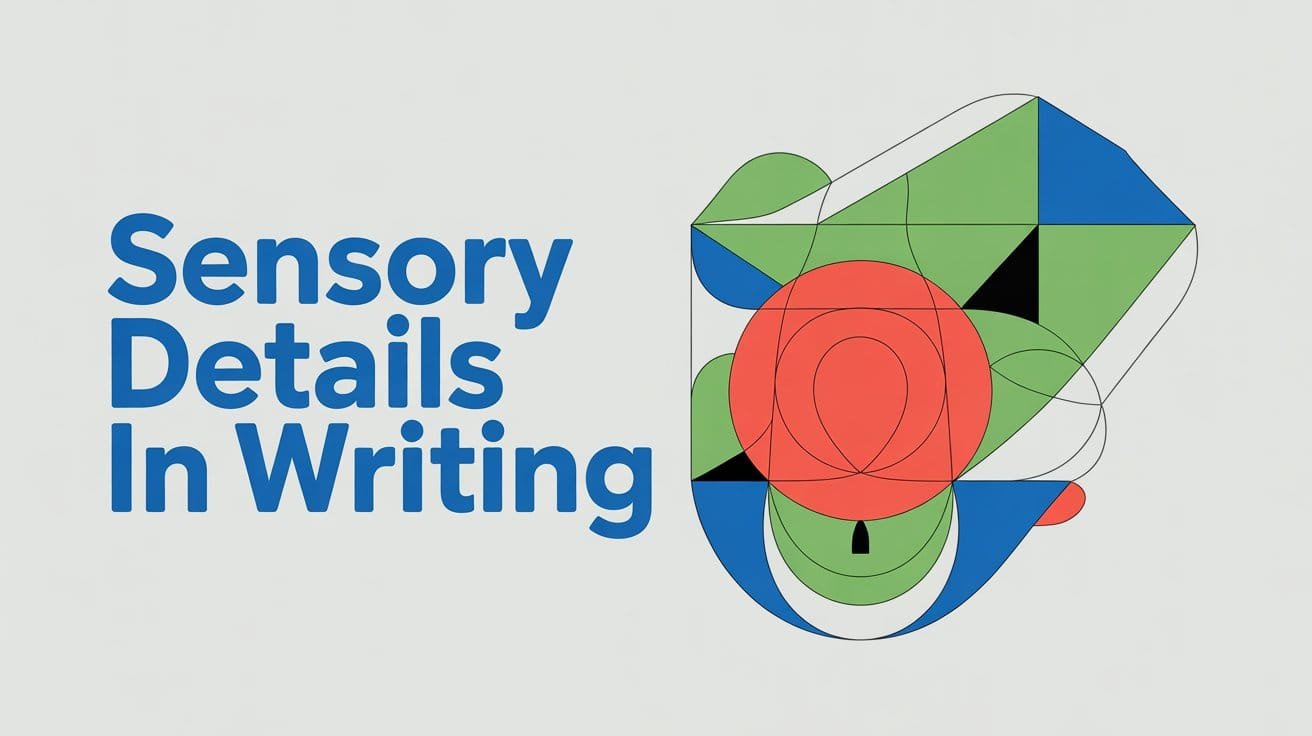Descriptive writing is more than just stating facts. It’s about helping readers see, hear, feel, smell, or even taste what you’re describing. One of the most effective ways to bring your writing to life is by using sensory details.
Sensory details help you create writing that feels vivid and real. When used well, sensory details turn simple sentences into scenes that feel active and memorable. This guide explains how sensory details work, why they matter in descriptive writing, and how you can use them to create stronger, more engaging descriptions in your own work.
What Are Sensory Details?
Sensory details are words or descriptions that appeal to one or more of the five senses: sight, sound, smell, taste, and touch. They help readers imagine what something looks like, how it sounds, how it feels, what it smells like, or how it tastes.
Instead of simply telling the reader what’s happening, sensory details show the experience by creating a clear and vivid mental picture.
Here’s a basic example:
- Without sensory detail:
“The room was nice.” - With sensory detail:
“The room was filled with soft yellow light, the scent of fresh flowers, and the quiet ticking of a wall clock.”
The second version helps the reader visualize the space, hear a sound, and even imagine a smell—all of which make the writing feel more real.
Why Use Sensory Details in Writing?
Sensory details make writing more than just words on a page—they turn simple descriptions into vivid experiences. By including what something looks like, sounds like, or feels like, you help readers step into your scene and stay engaged. Whether you’re describing a setting, building a character, or writing a narrative, sensory details give your words depth and texture.
Here are a few key reasons to use sensory details:
1. They Make Writing More Descriptive
Sensory language helps you describe things more clearly and specifically. Instead of saying “It was a cold day,” you might say, “A sharp wind stung my cheeks, and frost coated the sidewalk.”
2. They Help Readers Visualize
Well-chosen sensory words paint mental images. This helps readers understand your setting, characters, or actions without needing extra explanation.
3. They Create Mood and Atmosphere
The senses are powerful tools for setting the tone of a scene. A “musty basement with flickering lights” gives a completely different mood than a “sunlit room filled with the smell of fresh cookies.”
4. They Make Writing Memorable
When readers can imagine a scent, feel a texture, or hear a sound in your writing, the scene becomes more personal and memorable.
Sight – What Do You See?
Sight is the most commonly used sense in descriptive writing. It allows readers to visualize the setting, characters, actions, and objects you’re describing. By using clear visual details, you help paint a picture in the reader’s mind.
When describing what something looks like, consider including:
- Color – e.g., bright red, pale blue, golden
- Size and shape – e.g., towering trees, narrow alleys, round plate
- Lighting and shadow – e.g., dim light, glowing, flickering
- Movement – e.g., swaying, darting, gliding
- Patterns and texture (visible) – e.g., spotted, striped, cracked
Example (Before and After):
- Basic:
“The garden was beautiful.” - With sensory detail (sight):
“The garden was full of bright tulips in red and yellow, with butterflies fluttering above them under the warm afternoon sun.”
The revised version lets the reader see the colors, movement, and lighting, making the description more vivid.
When writing, ask yourself: What would I see if I were standing in this place?
Sound – What Do You Hear?
Sound adds depth and energy to writing. It helps readers imagine what’s happening around the scene—whether it’s quiet and calm or busy and noisy. Describing sound can make your writing feel more alive and realistic.
When writing about sound, you can include:
- Natural sounds – rustling leaves, chirping birds, crashing waves
- Human sounds – laughter, footsteps, whispers, shouting
- Mechanical or object sounds – ticking clocks, creaking doors, ringing phones
- Onomatopoeic words – words that imitate sounds like buzz, clang, sizzle
Example (Before and After):
- Basic:
“It was quiet in the morning.” - With sensory detail (sound):
“The soft chirping of birds and the distant hum of traffic filled the still morning air.”
The sound of birds and distant traffic helps the reader imagine the atmosphere more clearly.
When writing, ask: What sounds would I hear in this place or situation? Are they loud or soft? Constant or sudden?
Smell – What Do You Smell?
Smell is a powerful sense that often triggers memory, emotion, or atmosphere in writing. Even a simple scent can transport the reader’s mind to a different place or moment. It’s not used as often as sight or sound, though including smell in your descriptions can make your writing stand out.
When describing smells, consider:
- Pleasant scents – fresh bread, blooming flowers, clean air
- Unpleasant smells – garbage, smoke, damp socks, mildew
- Strong or faint smells – overpowering perfume vs. a hint of cinnamon
- Associations – does the smell remind the character of something?
Example (Before and After):
- Basic:
“The kitchen was nice.” - With sensory detail (smell):
“The kitchen smelled of baked apples, cinnamon, and warm vanilla.”
The added scents help the reader feel the coziness and warmth of the setting.
Ask yourself: What smells are in the air? Are they inviting, sharp, musty, or sweet? How do they affect the mood or memory in the scene?
Taste – What Do You Taste?
Taste brings flavor and emotion into writing, especially in personal narratives, food descriptions, or scenes involving meals and celebrations. It helps readers experience the flavor as if they’re tasting it themselves—whether it’s something enjoyable or unpleasant.
When describing taste, think about:
- Basic flavors – sweet, sour, salty, bitter, spicy, savory
- Texture in the mouth – creamy, crunchy, dry, juicy
- Temperature and intensity – hot soup, icy lemonade, tangy sauce
- Reactions – Did it make your mouth water? Did it burn? Was it bland?
Example (Before and After):
- Basic:
“The cake tasted good.” - With sensory detail (taste):
“The cake was rich and buttery, with layers of smooth chocolate and a hint of orange zest in every bite.”
This version lets the reader almost taste the cake through vivid descriptions.
Taste might not be relevant in every scene, but when it is, it can make your writing more engaging and emotionally resonant.
Touch – What Do You Feel?
Touch describes how things feel against the skin or how the body reacts to sensations like temperature, texture, or pressure. It helps readers experience a moment physically—whether it’s the feel of a cool breeze, a scratchy sweater, or a sharp sting.
When using touch in writing, think about:
- Texture – smooth, rough, soft, gritty, slippery
- Temperature – warm, cold, icy, steamy
- Physical sensations – itchy, sore, numb, aching
- Reactions – goosebumps, shivers, sweating, burning
Example (Before and After):
- Basic:
“The ground was uncomfortable.” - With sensory detail (touch):
“The dry grass scratched against her legs, and the hard ground pressed sharply into her back.”
The second version allows the reader to feel the physical discomfort more clearly.
Ask yourself: What would my body feel in this moment? Is it pleasant or irritating? Sharp or gentle?
Tips for Using Sensory Details Effectively
Adding sensory details can make your writing more vivid, but using them well takes balance and purpose. Here are some practical tips to help you use sensory language clearly and effectively:
1. Use Details That Fit the Scene
Choose sensory descriptions that match the mood, setting, or action. A rainy day might focus on the sound of raindrops and the damp chill in the air—not every sense needs to be used in every scene.
2. Be Specific, Not Overdone
Instead of saying “It smelled bad,” say “The air reeked of burnt toast and sour milk.” Specific details create stronger images without overloading the sentence.
3. Balance Sensory Detail With Clarity
Too much description can slow down your writing. Focus on one or two key senses that highlight what’s important. Use sensory language to support the meaning—not to distract from it.
4. Use Verbs and Adjectives Wisely
Descriptive verbs and adjectives can carry sensory meaning on their own. Words like shivered, sticky, glowed, or echoed naturally suggest a sensory experience.
5. Avoid Repetition
Don’t repeat the same type of sensory detail too often. Mix them across different senses to keep your writing fresh and varied.
6. Think Like the Reader
Imagine how your words may sound and feel to someone reading them for the first time. Will they be able to picture the scene? Can they hear or feel what you’re describing?
Using sensory details thoughtfully will make your writing more interesting, and easier for readers to connect with.
Sensory Details Examples in Writing
Below are some examples of sensory details in sensory-rich writing:
- A sudden crack of thunder shook the windows as cold rain splattered against the roof.
- The candle flickered gently, releasing a faint scent of vanilla and smoke.
- The bakery window displayed rows of pastries, their golden crusts gleaming and the buttery smell drawing people in from the street.
- The only sound was the faint ticking of the clock and the occasional creak of the wooden floor beneath his chair.
- She took a bite of the warm apple pie, the buttery crust flaking softly as the cinnamon filling melted on her tongue.
- The sharp scent of lemon filled the air as she peeled the fruit, and its tangy juice stung a small cut on her finger.
- He stepped into the cabin, where the wooden floor felt cool beneath his feet and the smell of old books and fireplace smoke lingered in the air.
FAQs About Sensory Details
What are the five sensory details?
The five sensory details correspond to the five senses:
Sight (what you see)
Sound (what you hear)
Smell (what you smell)
Taste (what you taste)
Touch (what you feel)
What are examples of sensory details in writing?
Examples of sensory details include phrases like “the scent of fresh rain,” “the rough texture of bark,” “the sharp taste of lemon,” “the echo of footsteps,” or “the warmth of sunlight on the skin.” These descriptions help readers imagine the scene more vividly by appealing to their senses.
Why are sensory details important in descriptive writing?
Sensory details help readers see, hear, smell, taste, or feel what’s happening in the text. They make writing more engaging, realistic, and memorable by bringing scenes and emotions to life.
How do you add sensory details to a sentence?
Start by thinking about what someone might experience in the moment—what they see, hear, feel, taste, or smell—and describe those elements clearly. Use specific adjectives and verbs, and try to show rather than tell.
Can sensory details be used in academic writing?
Yes, but they should be used carefully. In narrative essays or descriptive responses, sensory details can help illustrate a point. In formal academic writing, use them when appropriate for clarity or emphasis—but avoid overly emotional or creative language unless it supports the objective.



